A little bit of description of the classes I took, as I've finally got down to the bottom of my suitcase, and disentangled this mass of little samples etc. Each tutor had a slightly different approach to teaching and the available technology, and it was really interesting to observe.
(I'm trying a different way of uploading photos today as Flickr's new interface is driving me berserk! You should be able to click on the pictures and then choose a different size when you get to Flickr if you want to view more detail...)
ETA OK, it's really ugly for landscape photos. Back to the drawing board but I'm leaving this post the way it is...
This was one I'd swapped onto at the last minute (on Tuesday morning) because rearrangement meant I was double-booked on Thursday afternoon with both Nancy Bush and Annie Modesitt. There was an irony in this as they were the last two of my original choices, but by this point... Anyway, scanning the list, it turned out that Lucy Neatby was also teaching double knitting, this time in the round; and it was a wonderful class. (I suspect this could also have been called "double knitting, backwards in high heels")
Here are the little samples - the two-coloured one is a mixture of techniques. We covered "simple" double-knitting in the round - the sort where you have two tubes, one inside the other - and then patterned double-knitting - the sort which is a single, double-thickness fabric in different colours (so you could make lined mittens or socks). The smaller sample at the top is a marvel - a way of knitting in the round but also making a pocket as you go. I'm going to start this again in sock-weight to make an iPod sock with a full-length pocket for the headphones...
Lucy had loads of samples of her own double knitting work, including some wonderful socks with padded soles, and the Bubbles scarf. Most of her teaching was done by demonstrating in front of the class but she also used judicious clips from her DVD on the subject, with the sound turned down and her own commentary over the top, which gave a very good guide to holding the yarns in different ways. She also just flung millions of ideas of how you could use a particular bit of the technique which I was scribbling down as fast as I could - such an amazingly inventive mind.
I've been downloading and printing double knitting patterns ever since I got home; definitely something I'm going to be doing in future.
Thursday morning: Planning your Aran with Jared Flood
Unlike the previous day's class (which had a bit of homework so we'd brought our own yarn), this time the yarn was meant to be provided by the organisers; which sort-of-inevitably meant that there was uncertainty for the first 20 minutes until the "classroom assistant"(a fellow student) fetched enough for everyone. As Jared explained, the tutors were "going with the flow", presumably to save their own sanity! He was certainly very well-organised and we started as soon as we could on a simple cabled sample, with the idea of steeking and cutting it by the end of the class. We learned cabling without a cable needle (the same method I learned from Gwen last year, so that was nice confirmation that I was still doing it properly).
The second section was much more about design; lots of very helpful stuff about how cabled fabric behaves in relation to stockinette/stocking-stitch and how much more ease is required; and some good percentages in terms of yardage and no. of stitches to cast on. We had a look at allocating the different stitches and what sort of "breaks" you might put between them as design features. Jared drew lots of diagrams on the whiteboard to help illustrate the sort of calculation you might make. He also talked about swatching proportionally and showed some of his own swatches as well as a finished cardigan I remember seeing on his blog a couple of years back.
In the third bit, we looked at steeking; in this case a crocheted (double crochet (UK)/single crochet (US)) steek right up against the edge we were going to cut. My crocheting is.... well; let's say less than stellar; but I did manage it, and I was fairly chuffed with myself. And there's no sign of the steek falling apart.
I'm slightly dubious about the idea of steeking Arans - I like the fact that there's a wrong side and a right side for counting rows between cables and quite often go wrong on cabled socks, and I think you possibly need seams because of the weight of the garment. But having said that, Jared's sample garment was absolutely beautiful, and more lightweight than a lot of Arans I've made, so I might well try it. And learning this method of reinforcing steeks, as opposed to Alice Starmore's "cut now, and tidy up later" method, was really interesting. We also got some very good advice on how many stitches to pick up for button bands in rib/garter stitch etc.
Another great class, with a tutor with a lovely sense of humour - I suspect that was much required during the week...
Thursday afternoon: Nordic Color with Nancy Bush
The technique we were using is called Roositud, which is an Estonian inlay technique where you carry colours across the face of the work without having to carry them all the way round the circumference (there's a really clever trick for even rows). The yarns I'd brought were a bit eye-poppingly bright, but happily so were a couple of the samples Nancy had brought. She'd designed a little sachet pattern for us - I'm about a third of the way through it at the moment.
We started with a double-stranded long-tail cast-on. Anyone reading this who has heard me whining about this in real life knows that long-tail cast-on is about the only thing in knitting which regularly defeats me, and I was actually feeling very flustered as she demonstrated this one, which had not only the usual manoeuvre I find very difficult but also a reverse version for alternate stitches. I had genuine visions of attempting to cast on for the entire 3 hours. (It did take me 4 hours to cast on 64 stitches for a sock once).
However, something miraculous happened and it just clicked in this class; I got the 42 stitches onto my needles and I wasn't even last to finish! I'll have to try it again and see whether something in my head has now finally got it.
Once we'd got the technique (there are two or three things a couple of us couldn't work out to start with, which were blindingly obvious when explained) it was a matter of practice; so while we were knitting away Nancy told us all about knitting in Estonia, and her experiences of travelling in that country. She also talked a bit about her involvement as the editor of the English version of the Haapsalu shawl book we've been raving about at I Knit recently. Fascinating.
My sample is a bit clumsy but I will finish it (not only because I'm stubborn and tenacious, but also because I can say that I have 6 stitches in it which were knitted by Nancy Bush - she used my piece to demonstrate but had to pick most of it out so I could try it myself) - I could see this working much better on the scale the Estonians use it at, on socks and gloves. Disappointingly, as it's the first time I've worked with it, the Biggam yarn (yellow) felt more like an acrylic than the pure merino it actually is. Maybe it's just the colour association...
Friday morning: Triangular Shawl Workshop with Elizabeth Lovick
This was a changed class, originally to be with Miriam Felton who has a pretty modern take on shawls I love; but nonetheless I really enjoyed it because again, it was a real expert teaching us about traditional Shetland shawls. Liz talked us through all sorts of triangles, tesselating them and showing on a PowerPoint presentation how different knitted samples fit together, before talking us through a number of differently shaped shawls she'd designed and made, all based on triangles. In the second part of the class we could either start to design our own based on a template she handed out, or for those who were less experienced with lace, start to knit one according to a pattern. I opted for the first possibility, and now have a chart produced for a shawl.
(I think, however, I've made a mistake on the left-hand side so am about to rip back and possibly start again on slightly smaller needles).
One excellent thing I hadn't seen/heard of before was that Liz had made a CD of her presentation, the notes and templates for us to take away; I'm sure that'll see a lot of use and it was a great idea.
Saturday: Whip Your Knits into Shape with Joan McGowan Michael
This was a class I was particularly looking forward to due to my rather hard-to-fit figure; it was meant to be happening on the Tuesday but Joan very sensibly stayed in California until the whole paperwork situation was resolved, and agreed to teach it on Saturday instead. And it was excellent.
We started off by measuring each other in pairs. And I'm not talking about just doing a quick bust, waist and hip measurement here. All told, we took something like 27 measurements. The slightly hilarious thing was that to get the measurements accurately placed, we wrapped each other in masking tape at the appropriate points. (Joan had brought a full-sized polystyrene torso, pre-taped, in her suitcase. I have no idea what that looks like on an airport X-ray. Apparently she keeps her shoes in it, in transit...) There's a modicum of embarrassment in probing a relative stranger's chest to see where the top of her breasts are, but we got over that quite quickly! Joan was circulating to check that we were putting tape in the appropriate places, and then we got onto doing stuff with tape measures...
At the end of the morning and in the afternoon, we then plotted all the figures onto brown paper (which was, miraculously, provided as promised- it wasn't there at the beginning of the class but had arrived before it was needed) to make a dressmaker's type paper pattern of our measurements. This isn't a good photo but gives you an idea. The template for the back is on top, with the one for the front underneath.
Some of the results were fascinating compared to what I'd have expected - I knew my front was an awful lot bigger than my back, but hadn't really fully considered what that meant for armhole shaping, for instance; and I've now got a good idea where I'd start short-rowing to create more fulness to get the 5" extra I need so the hemline of a garment is in the same place all the way round! Really excellent class.
Aware that Marketplace was also going on on Saturday, and one or two participants hadn't had a chance to get over there yet due to rearranged classes on Friday, we sat down at the beginning and ran through the content of the class; there weren't too many of us for Joan to check measurements, and we were all happy to halve the the lunchbreak, and everyone was happy with the knitting aspects of short rowing which was meant to be the practical part, and really just wanted to do the design elements, so in the end we finished mid-afternoon and were able to do a little more light shopping too.
General impressions
Overall; I loved the degree of flexibility the tutors were able to show (and their grace under pressure); all the ones I had were supremely well-organised and extraordinarily well-versed in their subjects. And they were also happy to answer random questions at the end or in quiet moments about other topics they were knowledgeable about, aware that not everyone could take every class. (Somewhere I got the tip that you pick up as many stitches around an armhole when steeking as feels comfortable at the time, and then decrease down to the stated number in the next row; I'm not sure which tutor that came from though!)
I'm not someone who thinks of herself as a fangirl when it comes to knitting; I picked the tutors whose work I liked, and who were known for good technical or design skills. But having taken classes, yes, I am pretty fangirlish about all of them, and will be following their future work with much more interest in future.
My fellow students were also a really knowledgeable, friendly, attentive, good-natured bunch. I didn't have a single person in any of my classes who wanted to prove that they knew more than the tutor or the others in the class, or engaged in side-conversations when the tutor was doing a whole-class part of the instruction. I haven't been to many knitting classes (my formal class experience is more with experimental textiles in general), but I've usually found that I'm pretty quick and waiting for the next set of instructions (unless I'm being taught long-tail cast-on!); in Tour de France terms though, I was definitely in there with the peloton this week, which was just excellent.
Quite aside from the classes, there was also a lot of "informal learning" going on. I was making a shawlette with crochet-hook beading and showed at least a dozen people how to do this over breakfast or in the bar in the evening, and I was shown at least one new cast-off and watched lots of variants of knitting style. It seemed perfectly fine just to wander over to someone doing something you hadn't seen before and just stare at their hands for a while - well, everyone I asked if that was OK was perfectly fine with it and really friendly, anyway!
(Oh, and in general "informal learning", the Brits in the Saturday class were complimented on the effectiveness of their undergarments, and chanted "Bravissimo", more or less en masse... According to one of Joan's Ravelry posts, Shopping Was Done before she returned home...)
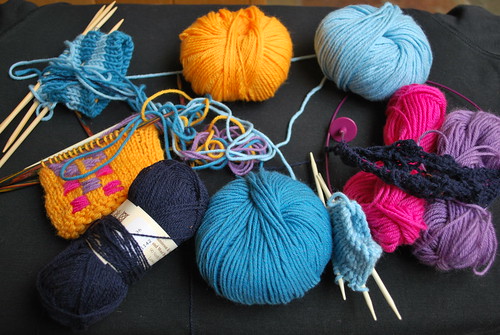
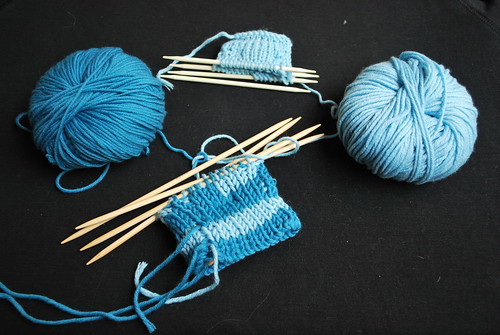
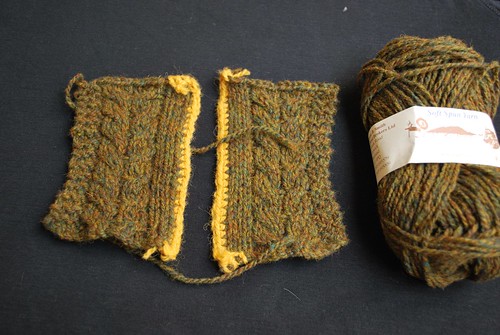
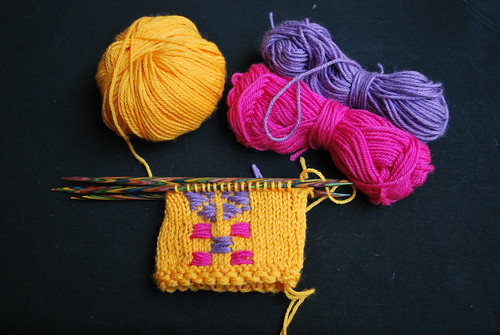
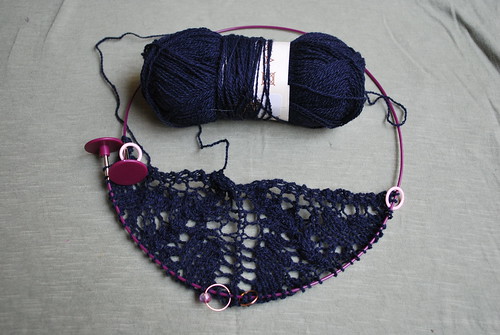
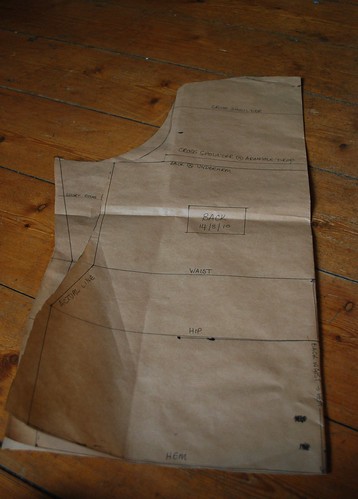
5 comments:
It sounds like you had some great classes! I haven't tried double knitting but it definitely sounds intriguing.
I love the sound of the classes, especially the Saturday one. Just the sort of thing I would love to do sometime.
Wow, I'm jealous, I could really do to learn any one of the great things you listed! Sounds like a wonderful time!
I forgot to tell you I talked about your review of KnitCamp in my podcast at the weekend and have put a link to your blog in the show notes. Really good reading - thanks for reviewing it so well.
Liz, thanks so much for the nice class review and for the tip on the wonderful bras!
My chest is now as immune to gravity as yours!!! Remarkable!
Post a Comment